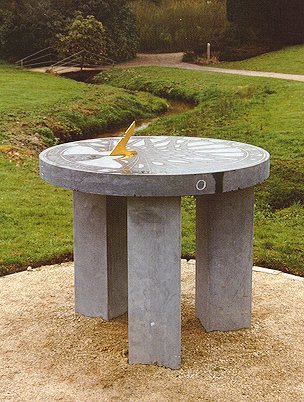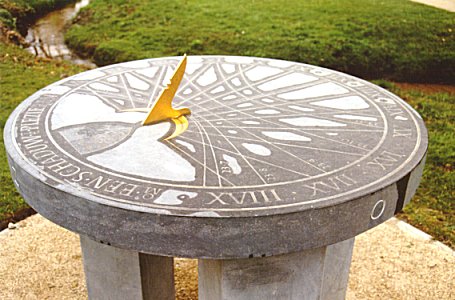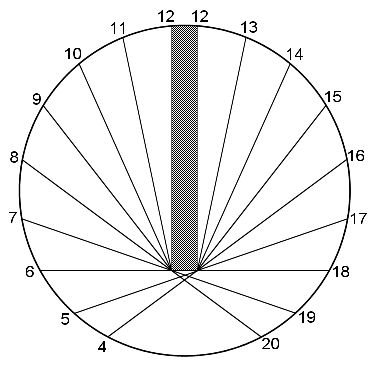
Sundial Park Genk
2. Horizontal sundial

Most horizontal dials belong to one of two size classes: the garden variety, with a dial face of some 30 cm (1 ft) and mounted on a pedestal, or the square or park variety, with a dial face several meters in diameter. This dial could be called 'table sized'. The stone measures 1.20 m (4 ft) in diameter and is supported by three heavy stone columns.
The picture was taken shortly after a shower. The areas between the engravings apparently dry faster.

This is in fact a combined horizontal pole-style and nodal dial. The time is read from the shadow of the gilded gnomon, from VI to XVIII hr local time. The 12 hr line is double, to accommodate the thickness of the gnomon: before noon the shadow of the western edge is used, after noon the eastern edge.
The tip of the W-shaped incision marks the date. Date lines are cut per zodiacal month, and the corresponding dates are engraved at the ends. The picture below was taken on 24 July, one month after the summer solstice, at about 9:15 hr local time.

The dial face has the coat of arms of the City of Genk and the motto Om een schaduw te plezieren, "To please a shadow". The side shows the cardinal directions E, S and W; latitude and longitude are engraved in the north side.
The sundial has been designed by Julien Lyssens, President of the Flemish Sundial Society, and was cut by stonemason Pieter Boudens (Belgium)
My comments:
Vandalism
 Vandalism is an unavoidable aspect of modern life, it seems, and Genk is no exception. The Park has no fence and cannot be locked at night, so it does get its share of damages. The Park maintenance crew is eager to repair any damage as soon as possible. Shabby objects would provoke an even faster deterioration...
Vandalism is an unavoidable aspect of modern life, it seems, and Genk is no exception. The Park has no fence and cannot be locked at night, so it does get its share of damages. The Park maintenance crew is eager to repair any damage as soon as possible. Shabby objects would provoke an even faster deterioration...
The blow recently inflicted to this object, however, is very painful. The gnomon was completely beaten off the stone, and this is not easily repaired.
The thick gnomon
 The information panel as well as the brochure mention a time range from 5 to 19 hr. Aesthetically, it was a good choice to omit the first and last hour, I think. It is also gnomonically better. From 7 to 11 hr the western edge of the gnomon is used as the pole-style, and from 13 to 17 hr the east side. After 18 hr, however, the western edge becomes the active edge again. Similarly, before 6 hr the eastern edge should be used. A complete dial face would look like this. Not nice for the engraver, nor for the visitors.
The information panel as well as the brochure mention a time range from 5 to 19 hr. Aesthetically, it was a good choice to omit the first and last hour, I think. It is also gnomonically better. From 7 to 11 hr the western edge of the gnomon is used as the pole-style, and from 13 to 17 hr the east side. After 18 hr, however, the western edge becomes the active edge again. Similarly, before 6 hr the eastern edge should be used. A complete dial face would look like this. Not nice for the engraver, nor for the visitors.
Roman numerals
The hours are marked in Roman numerals. Most often the 12-hr numbering system is used in that case: IV-XII and I-VIII hr. Here the 24-hr system is employed. Not my favorite choice; it always takes me some mental calculations before knowing how late XIV or XVIII hr is. One advantage might be that this avoids the four o'clock problem...
The crescent
The purpose of the crescent-shaped, gilded groove is not clear to me. It has no drain, so it fills easily with mud.